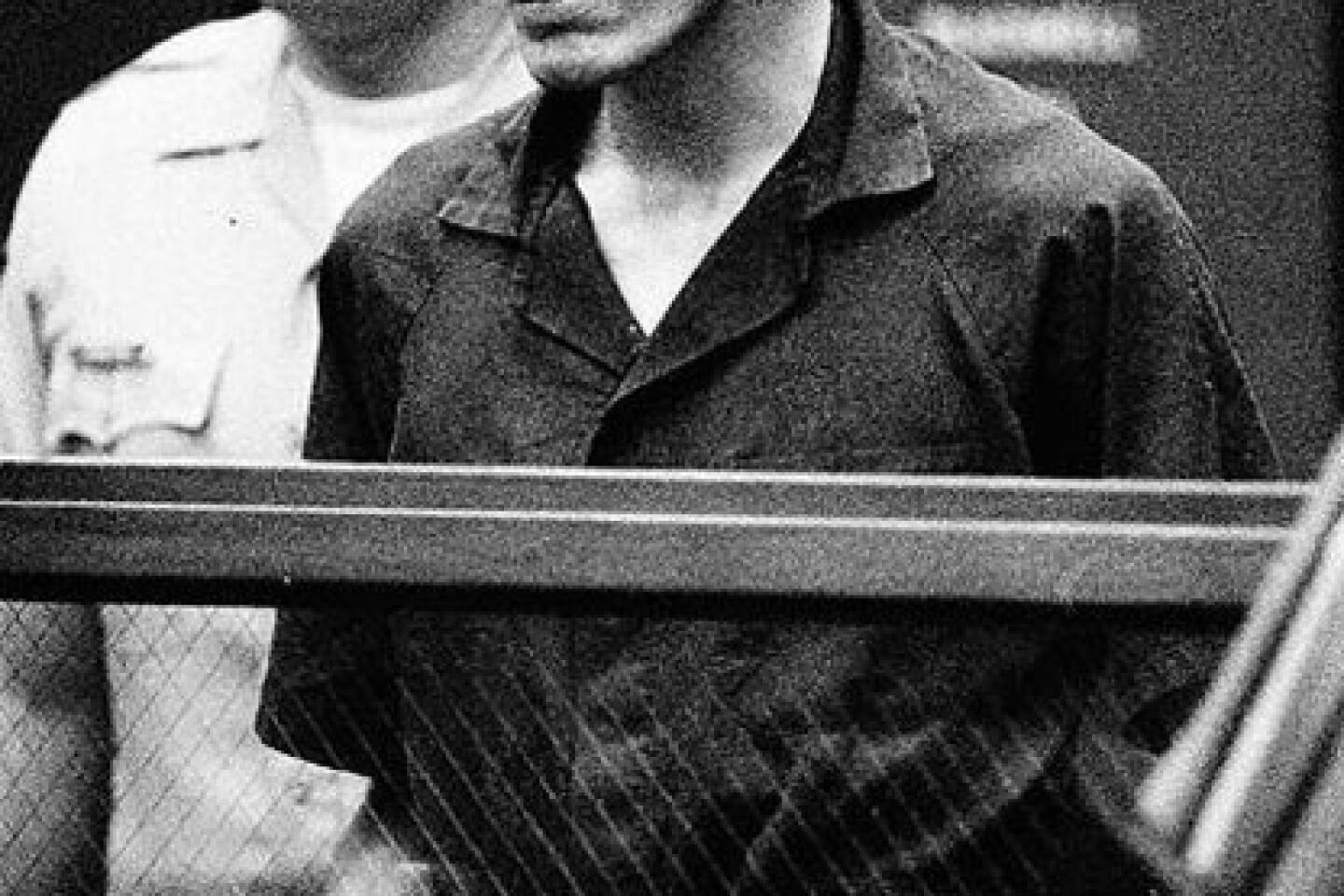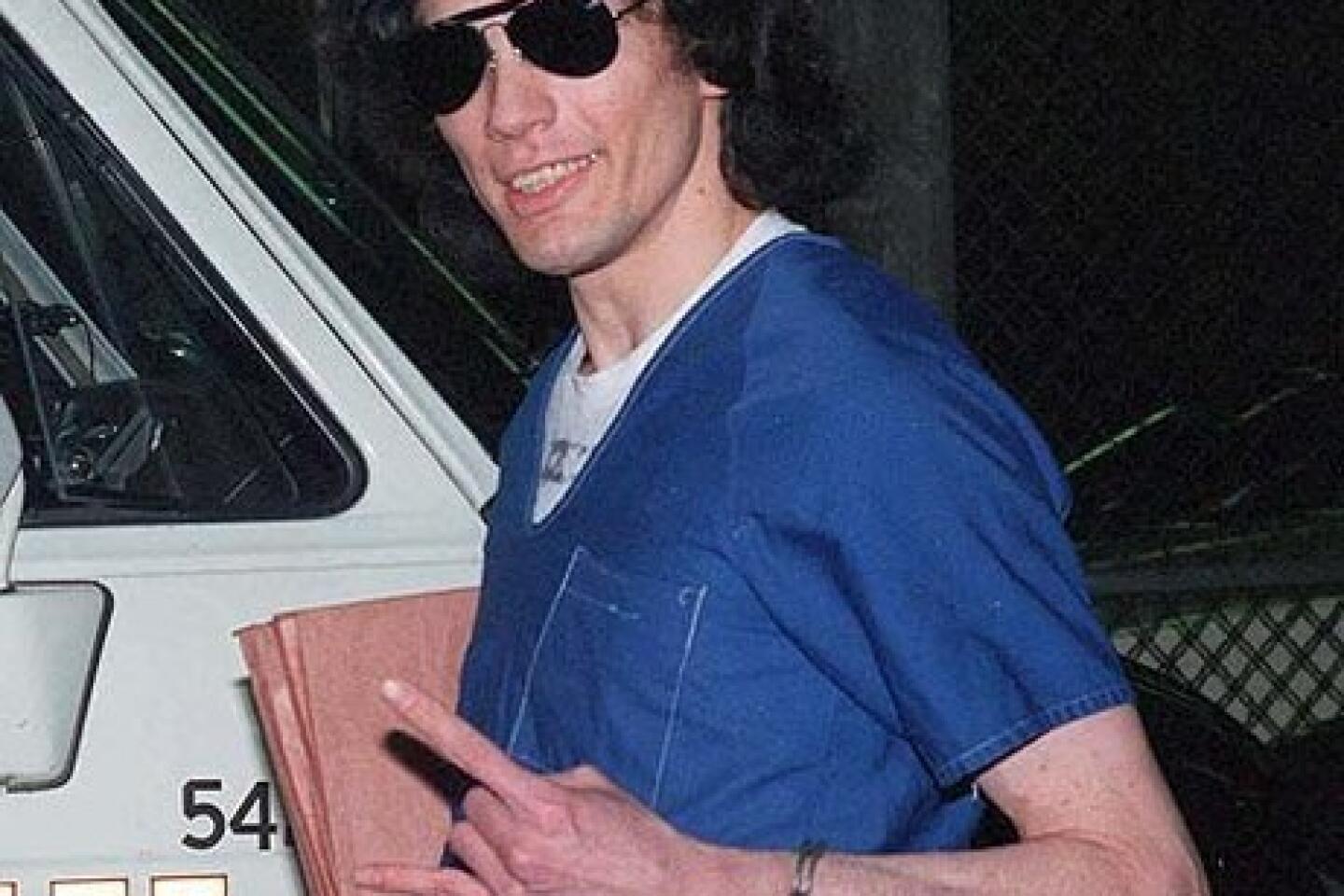Timeline: Night Stalker Richard Ramirez’s L.A. reign of terror and its aftermath
Reports of his brutality left a generation of Angelenos in fear when night fell.
Under cover of darkness in 1985, Richard Ramirez went on a months-long spree of murder, sexual assaults and other crimes that spread terror and anxiety throughout the Southland. Monterey Park, Whittier, Arcadia, Rosemead and Monrovia — no suburban window felt safe from his intrusion. His reign of terror yielded many monikers, including the Walk-In Killer and the Valley Intruder. But the Night Stalker would ultimately become synonymous with his modus operandi.
Now, Netflix has turned its true crime lens on the startling period. Premiering Wednesday, “Night Stalker: The Hunt for a Serial Killer” traces the full toll of the terror inflicted by Ramirez through the people whose lives were forever altered by his gruesome crimes.
The four-part series, which was directed by Tiller Russell, includes interviews with Frank Salerno and Gil Carrillo, the two lead Los Angeles County Sheriff’s Department detectives who worked tirelessly to track down the killer as well as survivors of Ramirez’s ruthless violence and journalists who covered the savagery and the manhunt.
Ramirez was convicted on 13 counts of murder and 30 other felonies in 1989 and sentenced to death. He died in 2013 from complications related to B-cell lymphoma.
Here is a timeline of selected developments involving L.A.’s most notorious serial killer, as reported by The Times.
Netflix’s four-part docuseries “Night Stalker: The Hunt for a Serial Killer” deftly captures a time and place that many Angelenos will never forget.
Aug. 10, 1985: Officers now believe at least 6 killings are linked to 1 man
The Times reports that the March 17 shooting death of a 35-year-old woman in her Rosemead condominium might have been the first in a countywide series of at least six slayings linked to a killer who enters an unlocked home at night to attack his victims as they sleep.
Aug. 14, 1985: Homicide cop is the perfect man for the job
“You don’t want this guy following you,” one former sheriff’s investigator tells The Times of Sheriff’s Sgt. Frank Salerno, lead detective in what was then known as the Valley Intruder case. “Sooner or later, he’s successful.”
Aug. 14, 1985: Police calls surge with crime spree
San Fernando Valley residents frightened by the brutal attacks of the so-called Valley Intruder phone police with false sightings of prowlers and with questions about forming neighborhood watch groups and securing their homes.
Aug. 25, 1985: The Valley Intruder: The victims’ stories
“The Valley Intruder or Night Stalker, as detectives have dubbed him, preys mainly on the most vulnerable — children, women living alone, elderly couples,” The Times reports. “Most often... he has crept through unlocked windows and doors before dawn, attacking while his victims slept.”
Aug. 26, 1985: Valley Intruder assaults two in Orange County
The assailant known as the Valley Intruder because most of the crimes attributed to him occurred in the San Gabriel and San Fernando valleys commits his first assault in Orange County little more than a week after an attack in San Francisco’s Lakeside District. “This proves he is back in the Southland,” says Los Angeles County Sheriff’s Deputy Sam Jones.
Aug. 28, 1985: Random auto checks held after Night Stalker attack
After responding to “hundreds and hundreds of phone calls” from frightened residents, Orange County Sheriff Brad Gates says deputies are randomly stopping suspicious-looking motorists and bolstering neighborhood patrols to reduce the chance of a second attack in the county by a killer dubbed the Night Stalker.
Aug. 31, 1985: Police identify stalker suspect
An all-points-bulletin is issued for Richard Ramirez, 25, of Los Angeles, suspected of being the Night Stalker whose rampage of kidnapping, rape and murder spread fear from Orange County to San Francisco.
Sept. 1, 1985: Citizens capture stalker fugitive
“Thank God you came,” Ramirez told an officer who took him into custody after he was chased, beaten with a steel rod and cornered by four angry citizens in East L.A.
May 7, 1986: Ramirez ordered to stand trial in 14 stalker murders
After a 29-day preliminary hearing involving 143 prosecution witnesses, Los Angeles Municipal Judge James F. Nelson orders Ramirez to face 14 counts of murder and 36 other felony charges related to his crime spree.
Aug. 26, 1986: Shattered Dreams: Night Stalker victim fights to regain his memory, rebuild life a year after attack
“Why me? I still ask it. Why did he pick our house?” says electrical engineer Bill Carns, attacked one year earlier while at home with his partner, Inez Erickson, in Mission Viejo. “I thought, ‘Why do it to me?’ What did I do to him?’ ... For the longest time, I thought it was revenge. Like I pissed him off one day or pulled in front of him. Anything that would explain it. Now I realize the man is mentally deranged.”
Jan. 30, 1989: After 3 years in jail, Ramirez will go on trial in Night Stalker murders
At the start of his trial, The Times reveals details about Ramirez’s time behind bars awaiting trial, from his voracious reading habits to his chilling words: “I love to kill people. I love watching people die,” he reportedly told Sheriff’s Deputy Jim Ellis following his 1985 arrest. “I love all that blood.”
Jan. 31, 1989: Jurors begin to hear grim tale of alleged Night Stalker crimes
Amid heavy security, Ramirez’s trial begins — and the opening statement of Los Angeles Deputy Dist. Atty. Phil Halpin provokes gasps in the courtroom at the gruesome details it recounts about the case.
Sept. 21, 1989: Ramirez guilty on all Night Stalker murder charges
After 22 days of deliberations, a Los Angeles Superior Court jury of seven women and five men convicts Ramirez on all counts. “As he was taken from the courthouse,” The Times reported, “Ramirez flashed a two-finger ‘devil sign’ to photographers. Asked what he thought about the verdicts, he issued a one-word comment: ‘Evil.’”
Nov. 8, 1989: Ramirez must die, Stalker judge decides
“I am beyond good and evil,” Ramirez says at the sentencing. “I will be avenged. Lucifer dwells in us all. That’s it.”
The Times TV team selects the 15 shows we’ll be watching when they premiere or return in 2021.
June 7, 2013: Richard Ramirez, Night Stalker serial killer, dies at 53
Sentenced to death following his conviction in 1989, Ramirez, who was housed at San Quentin and died in Marin General Hospital, was at the time one of 735 offenders facing execution and among the 59 of that number who had died from natural causes since capital punishment in California was reinstated in 1978.
June 7, 2013: Night Stalker prosecutor says Ramirez death ends ‘tragic period’
“I would like to think that with the advances in technology that if a serial killer is operating they would be identified and apprehended quickly,” Halpin’s co-prosecutor, Deputy Dist. Atty. Alan Yochelson, tells The Times.
June 7, 2013: Night Stalker held Southern California captive in 1985
“For once, the tabloid nickname didn’t overstate it,” Times columnist Patt Morrison wrote of the case’s “grotesque touches” after Ramirez’s death: slit throats, gouged-out eyes, a pentagram written in lipstick, shouts of “Hail, Satan!”
June 8, 2013: Night Stalker Richard Ramirez’s death: Many ask what took so long
Reyna Pinon, the wife of Faustino Pinon, one of the citizens who helped capture Ramirez in 1985, tells The Times that there are feelings of bitterness about the way the killer died: “To me, he had a better death than all those people whose lives he took.”
June 9, 2013: How the Night Stalker got his name
Richard Ramirez was named the Night Stalker — the name of a fictional 1972 TV movie and short-lived series about a number of Las Vegas murders committed by a vampire — during an editorial “rump session” at the Los Angeles Herald Examiner.
August 30, 2017: The Night Stalker taught Orange County you can’t master plan away the darker elements of human nature
“What was our town worth — a homogeneously boring cluster of tract homes and shopping malls — if it wasn’t pristine, safe?” writes novelist Alan Drew, who grew up in Irvine, in a Times Op-Ed. “The power of master planning was the illusion that the only things we had to fear existed outside of the town’s borders.”
More to Read
The complete guide to home viewing
Get Screen Gab for everything about the TV shows and streaming movies everyone’s talking about.
You may occasionally receive promotional content from the Los Angeles Times.








